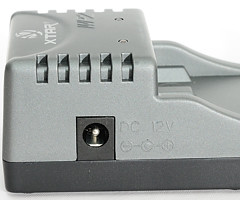Charger Xtar WP2

This charger was introduced in 2010 and announced as a CC/CV charger. It has two channels, i.e. it can do two cells independently of each other.


It comes in a cardboard box with a view to the charger and specifications on the back.



The charger is powered from a single 12 volt DC connector, this connector can be powered from either the supplied AC adapter or from a car adapter. The AC adapter I got is a universal voltage adapter (100 - 240 VAC 50/60 Hz) with a plug for European use.
There is a led for each channel, this led will be red when the charger is charging and green at all other times.





The charger can handle 70 mm long batteries, with flat top cells it is necessary to place them carefully to get a connection.
Measurements
Below 1.5 volt the charger does not charge, it discharges with 20-30 uA.
Between 1.5 and 2.8 volt the charger charges with about 80 mA.
Between 2.8 and 4.18 volt the charger is applying regular charge current (See curve below).
When the charge current goes below 200mA the charging is stopped and it will discharges with < 100 uA.
The charger will restart charging when the cell drops to 4.06 volt.
When charger is disconnected from power, but with a battery in, it will draw about 230 uA from the battery.
Two batteries will only change the current a little bit (about 5%).
Because each channel is independent, the different voltages varies between the channels with a small amount.

The charge curve shows a good approximation to a CC/CV charger, but the charger stops to early.

Same battery on the other channel, some small differences in terminating current and voltage can be seen.

My old 16340 IMR cell. Here is a problem with the difference between turn off point and turn on again, the battery drops enough in voltage to start the charger again. If the charger had terminated at a lower current, this restarting would have been a much smaller problem.

A closer look on all the noise in the current shows that the charger stops charging each time it want to measure voltage. This has the advantage that all connection resistance can be ignored and noise from the charger is eliminated.

The first curve did not show much noise in the charge current, but that was because I used a filter. Without a filter it can be seen that it contains a lot of noise.

In this chart I have zoomed in on the noise.
Conclusion
The charger is very close to a CC/CV charging profile and the trick about stopping charging to measure the voltage makes it possible to control the charge very precisely, but the chargers does not take advantage of this. Because it stops charging to early and does also start recharging at a high voltage, it is not a perfect charger. No charging at low voltages might also give problems activating a tripped protection.
Notes
Here is an explanation on how I did the above charge curves: How do I test a charger
















